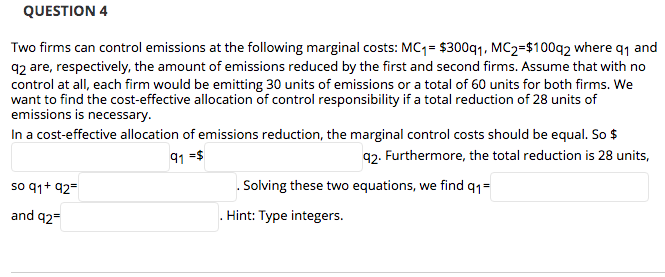Two firms can control emissions at the following marginal costs: MC;= $300q1, MC2=$100q2 where q1 and 92 are, respectively, the amount of emissions reduced by the first and second firms. Assume that with no control at all, each firm would be emitting 30 units of emissions or a total of 60 units for both firms. We want to find the cost-effective allocation of control responsibility if a total reduction of 28 units of emissions is necessary. In a cost-effective allocation of emissions reduction, the marginal control costs should be equal. So $ 91 =s 92. Furthermore, the total reduction is 28 units, so q1+ 92" . Solving these two equations, we find q1= and 92- Hint: Type integers.
Two firms can control emissions at the following marginal costs: MC;= $300q1, MC2=$100q2 where q1 and 92 are, respectively, the amount of emissions reduced by the first and second firms. Assume that with no control at all, each firm would be emitting 30 units of emissions or a total of 60 units for both firms. We want to find the cost-effective allocation of control responsibility if a total reduction of 28 units of emissions is necessary. In a cost-effective allocation of emissions reduction, the marginal control costs should be equal. So $ 91 =s 92. Furthermore, the total reduction is 28 units, so q1+ 92" . Solving these two equations, we find q1= and 92- Hint: Type integers.
Principles of Economics 2e
2nd Edition
ISBN:9781947172364
Author:Steven A. Greenlaw; David Shapiro
Publisher:Steven A. Greenlaw; David Shapiro
Chapter12: Environmental Protection And Negative Externalities
Section: Chapter Questions
Problem 12SCQ: Consider the case of global environmental problems that spill across international borders as a...
Related questions
Question

Transcribed Image Text:QUESTION 4
Two firms can control emissions at the following marginal costs: MC1= $300q1. MC2=$100q2 where q1 and
92 are, respectively, the amount of emissions reduced by the first and second firms. Assume that with no
control at all, each firm would be emitting 30 units of emissions or a total of 60 units for both firms. We
want to find the cost-effective allocation of control responsibility if a total reduction of 28 units of
emissions is necessary.
In a cost-effective allocation of emissions reduction, the marginal control costs should be equal. So $
91 =s
92. Furthermore, the total reduction is 28 units,
so q1+ 92=
. Solving these two equations, we find q1=
and 92=
. Hint: Type integers.
Expert Solution
This question has been solved!
Explore an expertly crafted, step-by-step solution for a thorough understanding of key concepts.
This is a popular solution!
Trending now
This is a popular solution!
Step by step
Solved in 3 steps

Knowledge Booster
Learn more about
Need a deep-dive on the concept behind this application? Look no further. Learn more about this topic, economics and related others by exploring similar questions and additional content below.Recommended textbooks for you

Principles of Economics 2e
Economics
ISBN:
9781947172364
Author:
Steven A. Greenlaw; David Shapiro
Publisher:
OpenStax



Principles of Economics 2e
Economics
ISBN:
9781947172364
Author:
Steven A. Greenlaw; David Shapiro
Publisher:
OpenStax

